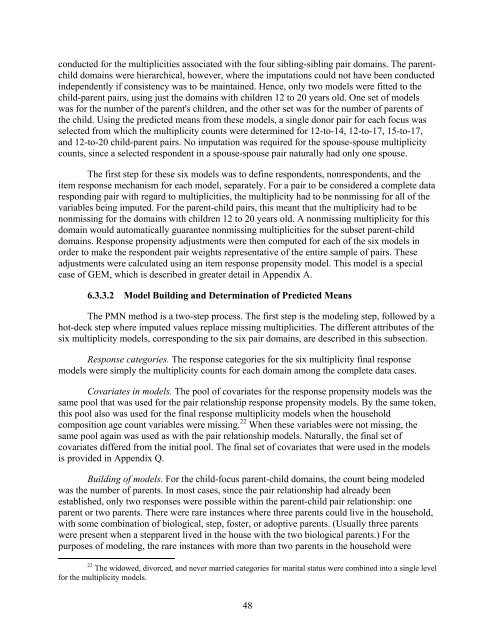Questionnaire Dwelling Unit-Level and Person Pair-Level Sampling ...
Questionnaire Dwelling Unit-Level and Person Pair-Level Sampling ...
Questionnaire Dwelling Unit-Level and Person Pair-Level Sampling ...
You also want an ePaper? Increase the reach of your titles
YUMPU automatically turns print PDFs into web optimized ePapers that Google loves.
conducted for the multiplicities associated with the four sibling-sibling pair domains. The parentchild<br />
domains were hierarchical, however, where the imputations could not have been conducted<br />
independently if consistency was to be maintained. Hence, only two models were fitted to the<br />
child-parent pairs, using just the domains with children 12 to 20 years old. One set of models<br />
was for the number of the parent's children, <strong>and</strong> the other set was for the number of parents of<br />
the child. Using the predicted means from these models, a single donor pair for each focus was<br />
selected from which the multiplicity counts were determined for 12-to-14, 12-to-17, 15-to-17,<br />
<strong>and</strong> 12-to-20 child-parent pairs. No imputation was required for the spouse-spouse multiplicity<br />
counts, since a selected respondent in a spouse-spouse pair naturally had only one spouse.<br />
The first step for these six models was to define respondents, nonrespondents, <strong>and</strong> the<br />
item response mechanism for each model, separately. For a pair to be considered a complete data<br />
responding pair with regard to multiplicities, the multiplicity had to be nonmissing for all of the<br />
variables being imputed. For the parent-child pairs, this meant that the multiplicity had to be<br />
nonmissing for the domains with children 12 to 20 years old. A nonmissing multiplicity for this<br />
domain would automatically guarantee nonmissing multiplicities for the subset parent-child<br />
domains. Response propensity adjustments were then computed for each of the six models in<br />
order to make the respondent pair weights representative of the entire sample of pairs. These<br />
adjustments were calculated using an item response propensity model. This model is a special<br />
case of GEM, which is described in greater detail in Appendix A.<br />
6.3.3.2 Model Building <strong>and</strong> Determination of Predicted Means<br />
The PMN method is a two-step process. The first step is the modeling step, followed by a<br />
hot-deck step where imputed values replace missing multiplicities. The different attributes of the<br />
six multiplicity models, corresponding to the six pair domains, are described in this subsection.<br />
Response categories. The response categories for the six multiplicity final response<br />
models were simply the multiplicity counts for each domain among the complete data cases.<br />
Covariates in models. The pool of covariates for the response propensity models was the<br />
same pool that was used for the pair relationship response propensity models. By the same token,<br />
this pool also was used for the final response multiplicity models when the household<br />
composition age count variables were missing. 22 When these variables were not missing, the<br />
same pool again was used as with the pair relationship models. Naturally, the final set of<br />
covariates differed from the initial pool. The final set of covariates that were used in the models<br />
is provided in Appendix Q.<br />
Building of models. For the child-focus parent-child domains, the count being modeled<br />
was the number of parents. In most cases, since the pair relationship had already been<br />
established, only two responses were possible within the parent-child pair relationship: one<br />
parent or two parents. There were rare instances where three parents could live in the household,<br />
with some combination of biological, step, foster, or adoptive parents. (Usually three parents<br />
were present when a stepparent lived in the house with the two biological parents.) For the<br />
purposes of modeling, the rare instances with more than two parents in the household were<br />
22 The widowed, divorced, <strong>and</strong> never married categories for marital status were combined into a single level<br />
for the multiplicity models.<br />
48
















